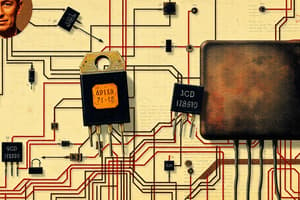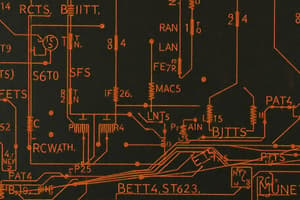Podcast
Questions and Answers
Explain the parameter construction symbol for a transistor and its components.
Explain the parameter construction symbol for a transistor and its components.
The parameter construction symbol for a transistor includes the doping level of different layers, sizes of different layers, two-diode analogy, and the transistor in active mode. The symbol also shows the emitter current (IE) for both npn and pnp transistors, along with the heavily doped, very lightly doped, and moderately doped layers for the emitter, base, and collector.
What are the different regions of operation in a BJT and how are they determined?
What are the different regions of operation in a BJT and how are they determined?
The different regions of operation in a BJT are determined based on the forward or reverse biasing of the base-emitter junction (JBE) and base-collector (JBC) junction. The four regions of operation are: 1. JBE reverse biased, JBC reverse biased 2. JBE forward biased, JBC forward biased 3. JBE forward biased, JBC reverse biased 4. JBE reverse biased, JBC forward biased.
Describe the differences between npn and pnp transistors in terms of doping and current flow.
Describe the differences between npn and pnp transistors in terms of doping and current flow.
Npn transistors have heavily doped (n+) emitter, very lightly doped (p-) base, and moderately doped (n) collector, while pnp transistors have heavily doped (p+) emitter, very lightly doped (n-) base, and moderately doped (p) collector. The current exits through the emitter in npn transistors, while it enters through the emitter in pnp transistors.
What is the significance of the sizes of different layers in a transistor's construction symbol?
What is the significance of the sizes of different layers in a transistor's construction symbol?
Explain the two-diode analogy in a transistor and how it relates to its construction symbol.
Explain the two-diode analogy in a transistor and how it relates to its construction symbol.
Flashcards are hidden until you start studying




